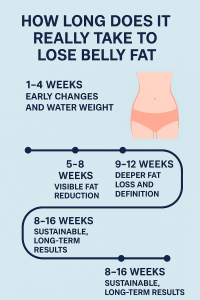How Long Does It Really Take to Lose Belly Fat
If you’ve ever looked in the mirror and wondered, “Why won’t this belly fat go away?” — you’re not alone. Millions of people struggle with abdominal fat because it’s the most stubborn and hormonally influenced fat on the body.
The truth? Losing belly fat takes time — not weeks, but often months of consistent effort. Let’s explore how long it really takes to shed belly fat, what affects the process, and what you can do to make it faster and healthier.
Understanding Belly Fat: The Science Behind It

Belly fat isn’t just about looks — it’s about health. Excess fat around your midsection increases the risk of heart disease, diabetes, and hormonal imbalances.
The Two Types of Belly Fat
-
Subcutaneous fat – The soft, pinchable fat just under your skin.
-
Visceral fat – The deep fat that surrounds your organs; it’s metabolically active and dangerous in excess.
Why Belly Fat Is the Hardest to Lose
-
It’s hormonally protected by cortisol and insulin.
-
The abdominal area has fewer fat-burning receptors than other parts of the body.
-
Stress, poor sleep, and genetics can make it accumulate faster and burn slower.
The Truth About Fat Loss Timing
The Role of Caloric Deficit
To lose fat, your body must burn more calories than it consumes — a concept called a caloric deficit. This triggers your body to convert stored fat into energy.
However, too large a deficit can backfire by slowing metabolism and increasing muscle loss.
Average Fat Loss Rate Per Week
A healthy fat loss rate is 1–2 pounds per week, depending on your starting point, age, and hormones. Losing faster often means you’re losing water or muscle, not fat.
How Long Does It Take to Lose Belly Fat? (Realistic Timeline)

Let’s break it down based on consistency, diet, and exercise habits.
Weeks 1–4: Early Changes and Water Weight
-
You’ll notice less bloating and water retention.
-
Energy and mood improve with cleaner eating and movement.
-
Scale weight may drop, but belly fat remains largely unchanged — yet.
Weeks 5–8: Visible Fat Reduction
-
Waist circumference begins to shrink.
-
Clothes fit better, posture improves, and visceral fat starts to burn.
-
Your body is now adapting to your new lifestyle.
Weeks 9–12: Deeper Fat Loss and Definition
-
The midsection becomes firmer as visceral fat decreases significantly.
-
You may see the first signs of muscle definition.
-
Consistency in nutrition and strength training pays off here.
3–6 Months: Sustainable, Long-Term Results
-
For most people, visible belly fat reduction happens within this range.
-
At this point, hormonal balance and muscle gain sustain your results.
-
The key: patience and habit consistency.
Summary:
💡 Realistic belly fat loss timeline: 8–16 weeks for visible results, 3–6 months for major transformation.
Factors That Influence How Fast You Lose Belly Fat
Gender and Hormones
Women have more estrogen, which encourages fat storage around the hips and belly. Men, on the other hand, accumulate visceral fat faster but also lose it faster due to higher muscle mass.
Age and Metabolism
After 30, muscle mass decreases by 3–8% per decade, slowing your metabolism. This makes fat loss slower, but not impossible — strength training can reverse this trend.
Stress, Cortisol, and Belly Fat
Cortisol — your stress hormone — signals your body to store fat around the midsection. Chronic stress, poor sleep, and emotional eating all raise cortisol, making belly fat resistant to change.
Proven Strategies to Lose Belly Fat Effectively
Nutrition: Eat for Fat Loss, Not Starvation
-
Focus on whole, unprocessed foods: lean proteins, fiber, and healthy fats.
-
Avoid added sugars and refined carbs — they spike insulin and promote fat storage.
-
Try the 80/20 rule: eat nutrient-dense meals 80% of the time and indulge moderately 20%.
💡 Tip: Protein-rich diets boost metabolism by up to 15%, helping your body burn fat more efficiently.
Exercise: What Works and What Doesn’t
-
Strength training builds lean muscle, increasing calorie burn even at rest.
-
Cardio (brisk walking, cycling, swimming) burns stored fat.
-
HIIT (High-Intensity Interval Training) is proven to reduce visceral fat faster than steady cardio.
-
Skip endless crunches — you can’t spot-reduce belly fat, but you can strengthen your core.
Lifestyle Habits That Accelerate Results
-
Sleep: Aim for 7–9 hours nightly. Poor sleep increases cravings and slows metabolism.
-
Hydration: Water aids fat metabolism; dehydration stalls fat loss.
-
Stress management: Meditation, yoga, and mindful breathing lower cortisol naturally.
Common Myths About Belly Fat Loss
| Myth | Truth |
|---|---|
| You can lose belly fat in 2 weeks | True fat loss takes at least 8–12 weeks of consistency. |
| Crunches burn belly fat | They strengthen muscles but don’t target fat. |
| Skipping meals speeds up fat loss | It slows metabolism and raises cortisol. |
| Supplements can melt fat | No pill replaces consistent diet and exercise. |
| You need to do hours of cardio | 30–45 minutes of focused activity is enough with good nutrition. |
FAQs About Belly Fat Loss Timeline
1. How long does it take to lose belly fat for women?
Typically, 8–12 weeks for visible reduction, but hormonal factors may extend that timeline slightly.
2. How long does it take for men to lose belly fat?
Men often see results in 6–10 weeks, as they generally burn fat faster due to muscle density.
3. Can I lose belly fat without exercise?
Yes, through diet alone — but progress is slower, and maintaining muscle is harder.
4. What’s the fastest way to lose belly fat safely?
Combine strength training, high-protein diet, and stress management.
5. How do I know I’m losing belly fat?
Track waist measurements, progress photos, and how your clothes fit — not just the scale.
6. Can stress really stop fat loss?
Yes. Elevated cortisol promotes fat storage even if you’re eating in a deficit.
Conclusion: The Realistic Road to a Flat Stomach
There’s no magic shortcut — belly fat loss is a gradual, biological process that rewards consistency.
If you eat well, exercise smart, sleep deeply, and manage stress, you’ll see meaningful results in as little as 8–12 weeks, and lasting transformation within 3–6 months.
Remember: your goal isn’t perfection — it’s progress. Focus on building healthy habits, and the flat stomach will follow naturally.
👉 Learn more from Harvard Health – The Truth About Belly Fat.


